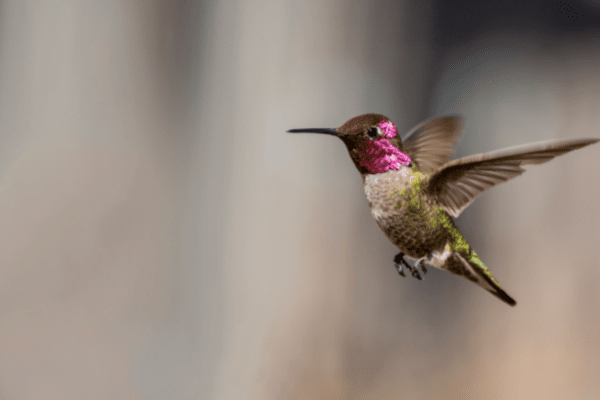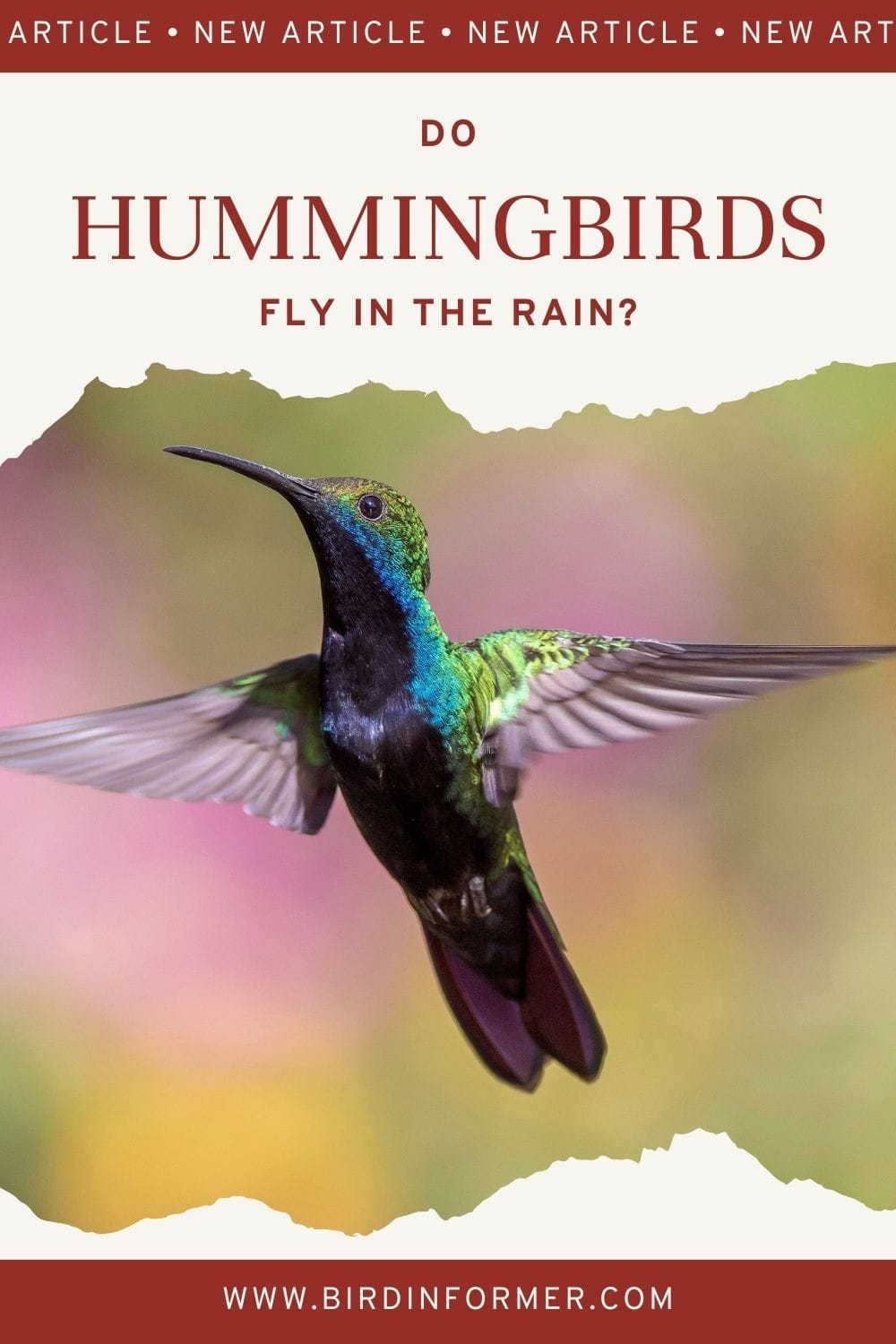Contents
- Do Hummingbirds Fly In The Rain?
- How Do Hummingbirds Fly When It Rains?
- Hummingbirds Flight and Its Difference With Other Birds
- Why Are Hummingbirds More Active When It’s Raining?
- Why Hummingbirds Adapted To Fly In Harsh Conditions
- How Hummingbirds Survive The Cold
- Final Thoughts On How Hummingbirds Fly In The Rain
Hummingbirds are one of the smallest bird species in the bird kingdom. However, despite their small size, these birds are not as fragile or helpless as we assume.
Unlike other bird species, hummingbirds have the ability to fly in the rain. They can fly and eat under different weather conditions, thanks to how their bodies have adapted to survive.
In this article, we’ll discuss more about how hummingbirds fly in the rain. We’ll expand our answer further and discuss:
- How hummingbirds fly in the rain
- How different their flying abilities are from other birds
- Why hummingbirds are more active when it’s raining
- How hummingbirds survive the cold
- Why hummingbirds adapted to fly under harsh conditions
If you’re interested to know more about these topics, let’s dive into how hummingbirds can fly in the rain…
Do Hummingbirds Fly In The Rain?
The quick answer is, yes, they do!
If we can give an award to the best fliers in the bird kingdom, hummingbirds would definitely be one of the top rankers. These birds have always been known for their ability to fly forward, backward, and sideways. And while most birds spend most of their time grooming their feathers and keeping them dry, hummingbirds are not bothered by it.
As their small bodies need to replenish food quickly, they find the need to fly continuously and search for something to eat. And this somehow made them adapt to a flying method that would help them survive in an undeniably big world.
Help These Wonderful Birds Find More Food With The Perfect Hummingbird Bird Feeder.
Their wing’s movement is a lot different than other birds, and it definitely moves faster. This is what gives us the illusion that hummingbirds hover mid-air when the truth is, their wings can actually fly up to a speed of 80 mph per second.
Amazing, right?
However, although hummingbirds can fly under light to medium-heavy rains, the same can’t be said to heavy rains.
Can Hummingbirds Fly Under Heavy Rain?
Hummingbirds are not invincible.
Although they are highly water-resistant and they have amazing technique, these are very small birds. During heavy rain, they’d have to fly fast, create rapid body shakes, and have to worry about the weight of rain droplets. And compared to light to moderate rain, the weight of a heavy rain droplet may not be something they can handle.
So at best, these birds choose to perch and just wait until the raindrops are lighter before flying out again.
They usually settle in dense vegetation on the downwind side of the tree trunk. And thanks to their powerful feet, they can grip hard on a twig causing them not to be blown away by the wind.
Can They Fly When Wet?
There are many situations where birds get wet:
- When they fly through a waterfall mist
- When they rub against wet leaves and rocks
- When they pass by sprinklers
- When they are hit by water dripping from leaves
And a whole lot more.
But while most birds stop every time they’re wet to clean up, hummingbirds aren’t as bothered. As a matter of fact, they might even spread their wings and embrace a light rain shower when they feel like it.
Since hummingbirds can fly under light to moderate rain, we can say that these birds can fly even when wet.
How Do Hummingbirds Fly When It Rains?
Hummingbirds can fly in the rain; that’s a fact. But, what makes it easy for them to do so?
Well, this is mainly because of their unique flying strategies. Unlike most birds who flap their wings, hummingbird wings rotate their wings and even increase their beating per second when the rain starts pouring harder.
Let’s take a look at this at a deeper level.
You see, you’re not the only one curious why hummingbirds seem to fly constantly and seem to hover in the rain. Even scientists wonder the same thing. According to research, three things contribute to the hummingbirds’ flying ability in the rain:
- Feathers
- Ability to “shake it off”
- Flight kinematics
Feathers
Hummingbird feathers can repel water, thanks to their design and the natural oil the birds apply to them during preening.
This is almost the same as the feathers of other birds. But what really makes hummingbirds special is their ability to shake it off and their fight kinematics.
Ability to “Shake it Off”
Researchers also found that hummingbirds can shake the water off their bodies while flying. The process is found to take 0.1 seconds, and then they’ll just continue flying. They do this as frequently as possible every time they’re too wet.
It’s almost like when we shake our heads back and forth, stop, and then do it again. For sure, it will get you very dizzy. But somehow, these little birds can do it.
Just watch this amazing video footage captured by the University of California in Berkeley:
Flight Kinematics
Last but not least is the hummingbirds’ ability to alter flight patterns.
In a study, a hummingbird was tested by letting it fly under varying amounts of rainfall. When the rain is light or moderate, hummingbirds make very few to no adjustments to how they fly.
But under heavy rain, they hover with a more horizontal body and tail position, increasing the surface area of their bodies exposed to rain. This then allows them to increase their wingbeat frequency, which makes it more tiring for the birds.
That’s why, although they can fly under heavy rain, they rarely do so and would rather perch and wait it out.
You can watch the video of how hummingbirds change their flight patterns below:
Combining these three factors makes hummingbirds very capable of flying under the rain, whether it’s light, moderate, or heavy. The only difference is that the birds exert more effort under heavy rain, making them more tired, so they opt to rest.
Hummingbirds Flight and Its Difference With Other Birds
Now let’s take a look at how hummingbirds’ flight differs from other birds. Why is it so special? And why are they the only birds that can do this?
Well, this is all thanks to their unique physiology.
- They are small and light, allowing them to maneuver in the air easily.
- They have hollow bones, fused vertebrae, and fused pelvic bones. This allows them to have lesser muscles and ligaments but is left with enough to support and protect their internal organs.
- They have larger pectoral or chest muscles, which allows them to move their wings. It is said that the hummingbirds’ pectoral muscles make up more than 25 percent of their body weight, which is significantly greater than other birds.
- They have tiny feet, which also makes them lighter. The consequence, though, is that they wouldn’t be able to walk; instead, they perch or slightly scoot sideways.
- They have longer and stronger bones at the edge of the wings, keeping them stable and easier to control.
- They have a larger heart to support their fast-flying and provide more oxygen throughout their body.
These physiological traits give them superior flying abilities that allow them to survive in a harsh environment.
Why Are Hummingbirds More Active When It’s Raining?
Like most birds, hummingbirds also love to bathe. And rain provides them an opportunity to do exactly that.
When it rains, hummingbirds usually preen their feathers. With their beak, they remove any dirt and parasites and smooth down any rough patches on their wings. This way, they can make sure that their feathers function well when they fly. They will also wipe the back of their head and neck area with their feet.
However, as much as they love water, hummingbirds don’t necessarily love flying under the rain. But it’s mainly because their bodies need to survive.
Why Hummingbirds Adapted To Fly In Harsh Conditions
If you love watching hummingbirds, the first thing you’ll notice is that they seem to not stop flying. And as we all know, flying can take up tons of energy, and with these little birds’ small bodies, they need to keep on eating.
Hummingbirds have a very high metabolism, which means they need to eat more frequently than other birds. And because of this, even if the weather condition is not great, they would fly out to feed.
These birds don’t really like the rain. And if given the opportunity, they would opt to drink on bird feeders with rain covers than those that don’t have them. Probably it’s an opportunity for them to get a little rest from battling against the heavy rain.
How Hummingbirds Survive The Cold
Since hummingbirds fly in the rain, have you ever wondered how they survive being in the cold? Well, this is all thanks to the following:
Insulating Feathers
Hummingbirds fluff their feathers to insulate themselves from the cold. As their body temperature is at 105 degrees Fahrenheit, fluffing their feathers allows them to trap this temperature within themselves and shield their body from the surrounding cold air.
This is why you can see them cute and plump at certain times.
Torpor
Hummingbirds also enter a state of sleep called Torpor to preserve their energy.
Whether it’s winter or a rainy night, hummingbirds decrease their body temperature and heart rate. The birds usually reduce their temperature by nearly 50 degrees Fahrenheit and maintain it at that.
You might find them dangling upside down on a branch or feeder looking lifeless, but this is really just them in a state of hummingbird sleep. Let them rest and preserve their energy, and when they’re ready, they’ll search for more food.
Shiver
When they wake up in the morning after a cold night or after torpor, hummingbirds shiver to awaken their muscles rapidly and start warming up.
The shiver process usually takes an hour before the body temperature goes back to normal. And because they used up their stored energy to warm their bodies, hummingbirds will fly off quickly to replenish energy lost by finding food.
Final Thoughts On How Hummingbirds Fly In The Rain
And that’s how hummingbirds can fly in the rain.
If you think about it, this world is too big and challenging for these small birds. But hummingbirds somehow manage to perform coping strategies to survive every day.
In summary, hummingbirds are excellent fliers. They can fly upwards, backward, sideways, and even under the rain. Thanks to their flight kinetics, feathers, and shaking abilities, they can easily adjust their flying from when it’s sunny and lightly raining to when it’s moderately raining and raining heavily.
There’s no denying that hummingbirds are among the best fliers in the bird kingdom, and their unique flying skills are proof of that.


